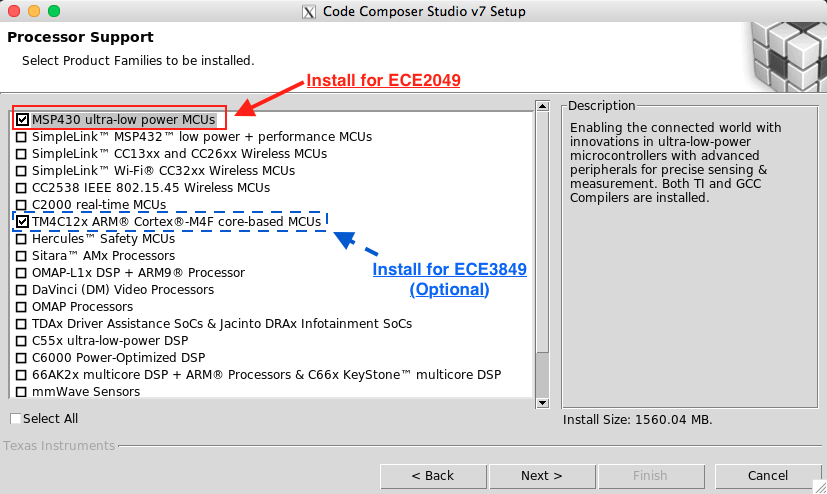CCS Install Guide
This guide provides instructions for installing TI’s Code Composer Studio (CCS) on your own machine. Specific instructions are provided for configuring a CCS install to support the labs in ECE2049 and ECE3849.
Before you start: System requirements
Windows
CCS should work out-of-the-box on most versions of Windows. We have tested it successfully with our hardware on Windows 7, 8, 10, and Server 2008. You will need at least 5GB of free disk space to complete the installation.
If you have Windows, you can skip directly to Downloading CCS.
Linux
Installing CCS on Linux is also possible, though slightly more
involved. TI provides install instructions for CCS on
Linux
here,
which are specific to Ubuntu Linux. We
recommend that you use Ubuntu version 18.04 or 16.04, for which TI
provides instructions. It is possible to run CCS
on other Linux distributions, though the installation process may be
tricky.
Before installing CCS, install all of the package dependencies
recommended in the TI instructions before running
the installer. If you are missing dependencies, the installer may
fail to run with little or no indication of why it failed.
If you don’t use a supported distribution or just don’t want to install CCS directly, another good option is to set up a virtual machine with the recommended version of Ubuntu and install CCS there. If you want to pursue this option, feel free to contact the instructor for details.
Mac OS X
TI also releases CCS for recent versions of Mac OS (Yoesmite and higher) with most features available.
To install CCS for Mac, see Downloading CCS.
Downloading CCS
You can download CCS v8.1 from TI’s website here:
http://processors.wiki.ti.com/index.php/Download_CCS
Download either the web-based installer or the full installation package (which is larger). In order to download the file, you may need to make an account on TI’s website and fill in some information–when requested, you can write “Education” as your intended use for the product.
If you have issues obtaining a download link from TI, please ask the course staff for help.
Installing CCS
Running the installer
Run the installer and select an install location for CCS on your computer when prompted. We recommend that you install CCS on your local hard drive–do NOT try to install it on a flash drive, or it will be very slow.
Toolchain support
After a few clicks, you will be prompted to select which types of TI you want to use with your CCS install. Select the options highlighted in red in the figure below to add support for the MSP430, which installs the necessary compilers and libraries (also called toolchains).
(Optional) If you intend to take ECE3849: Real-time Embedded Systems in the future, you may also want to select the options highlighted in blue so that your CCS install also supports the ARM development boards used in that course.

Once you have selected features, click Next. You may receive a warning indicating that certain boards are not supported–you can safely ignore this, as we do not use these boards in our classes.
Click Next again to see a list of emulators, which include the drivers to program attach a debugger to a target microcontroller. The default options for these settings should be fine: if you installed only the MSP430 tools, the options “MSP FETs” should be selected; if you also installed the tools for ECE3849, the Tiva emulator tools should also be selected.
Click Next again and then start the install. The installation procedure will take a while, so feel free to go outside or take a nap while it runs.
Testing your CCS install
The best way to test your CCS install is to load a project, build it, and to load it onto your development board. Please refer to the Lab 0 assignment for instructions on how to do this; in particular, you should follow the instructions for the following steps:
-
Create and load the “blink” project from lab 0: This will confirm that you have the correct compiler installed and can successfully attach a debugger to the development board.
-
Build and load the Lab 0 template (demo) project This will make sure that you have all of the required libraries installed for use in our labs.
If you can successfully build and load the above projects, you should be done!
Getting help
If you have issues with this install procedure, feel free to contact the course staff or come to office hours or lab for help.
For CCS-specific errors, it is also useful to search online for information about the error. CCS has a very good online community, so it’s often possible to find solutions to certain configuration issues online.
Frequently Asked Questions
No data yet! If you have questions, please ask them!